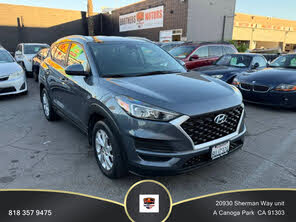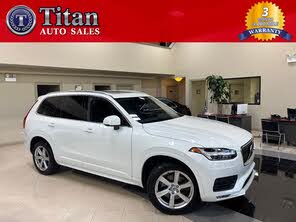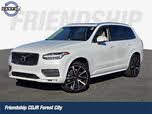2021 Hyundai Tucson vs 2020 Volvo XC90
Overview | |
MSRP$48,350 | MSRP$23,700 |
Listings301 | Listings675 |
Ratings & Reviews | |
User Reviews | User Reviews |
Expert reviews8.5 out of 10 | Expert reviews7.7 out of 10 |
Pros
Cons
| Pros
Cons
|
2020 Volvo XC90 Reviews SummaryThe XC90 has been one of our favorite family shuttles for 18 model years. This 3-row Volvo continues for 2020 as it was during its 2016 redesign, which brought dramatic new design language, chassis architecture, electrified powertrains, infotainment, and semi-automated driving capability. Among midsize SUVs, the XC90 is among the few I would recommend without any hesitation. Families who can afford to splurge will find a stylish and pampering truck that's built upon decades of safety research, which very few automakers can match. | |
2021 Hyundai Tucson Reviews SummaryIt’s no secret that small SUVs are among the most popular new-car segments. You see them everywhere on the road today. Automakers put a lot of pressure on themselves to continually offer the latest and greatest. But that also means even the not-so-new are still terrific vehicles and provide a great value. Case in point: the 2021 Hyundai Tucson. The current generation of this compact SUV was introduced for the 2016 model year, and this 2021 edition represents the final model year before a new generation is ushered in. So why go with the older model? Because Hyundai has loaded it up with plenty of tech and safety features and it is offered at a competitive price. | |
No video found | |
Popular Features & Specs | |
Engine2.0L 250 hp I4 | Engine2.0L 161 hp I4 |
Drive TrainFWD | Drive TrainFWD |
Seating Capacity7 | Seating Capacity5 |
Horsepower250 hp @ 5500 rpm | Horsepower161 hp @ 6200 rpm |
MPG City21 | MPG City23 |
MPG Highway30 | MPG Highway28 |
Engine | |
Engine Name2.0L 250 hp I4 | Engine Name2.0L 161 hp I4 |
Torque258 lb-ft @ 1500 rpm | Torque150 lb-ft @ 4700 rpm |
Horsepower250 hp @ 5500 rpm | Horsepower161 hp @ 6200 rpm |
DrivetrainFWD | DrivetrainFWD |
Fuel Economy | |
MPG City21 | MPG City23 |
MPG Highway30 | MPG Highway28 |
Interior | |
Seating Capacity7 | Seating Capacity5 |
Key Features | |
Sunroof/MoonroofStandard | Sunroof/Moonroof |
Safety | |
Front Crash Overall5 | Front Crash Overall5 |
Side Crash Overall5 | Side Crash Overall5 |
Dimensions & Capacity | |
Cargo Space15.8 cu ft | Cargo Space31.0 cu ft |
Curb Weight4375 lbs | Curb Weight3309 lbs |
Height69.9 in | Height64.8 in |
Length195.0 in | Length176.4 in |
Width84.3 in | Width72.8 in |
Wheelbase117.5 in | Wheelbase105.1 in |
Maximum Payload1210 lbs | Maximum Payload1146 lbs |
Number of doors4 | Number of doors4 |
Maximum Towing Capacity4000 lbs | Maximum Towing Capacity1500 lbs |
Overview | ||
MSRP | $48,350 | $23,700 |
Listings | ||
Ratings & Reviews | ||
User reviews | ||
Expert reviews | 8.5 out of 10Read full review | 7.7 out of 10Read full review |
Pros & cons | Pros
Cons
| Pros
Cons
|
Summary | The XC90 has been one of our favorite family shuttles for 18 model years. This 3-row Volvo continues for 2020 as it was during its 2016 redesign, which brought dramatic new design language, chassis architecture, electrified powertrains, infotainment, and semi-automated driving capability. Among midsize SUVs, the XC90 is among the few I would recommend without any hesitation. Families who can afford to splurge will find a stylish and pampering truck that's built upon decades of safety research, which very few automakers can match. | It’s no secret that small SUVs are among the most popular new-car segments. You see them everywhere on the road today. Automakers put a lot of pressure on themselves to continually offer the latest and greatest. But that also means even the not-so-new are still terrific vehicles and provide a great value. Case in point: the 2021 Hyundai Tucson. The current generation of this compact SUV was introduced for the 2016 model year, and this 2021 edition represents the final model year before a new generation is ushered in. So why go with the older model? Because Hyundai has loaded it up with plenty of tech and safety features and it is offered at a competitive price. |
Video | No video found | |
Popular Features & Specs | ||
Engine | 2.0L 250 hp I4 | 2.0L 161 hp I4 |
Drive Train | FWD | FWD |
Seating Capacity | 7 | 5 |
Horsepower | 250 hp @ 5500 rpm | 161 hp @ 6200 rpm |
MPG City | 21 | 23 |
MPG Highway | 30 | 28 |
Engine | ||
Engine Name | 2.0L 250 hp I4 | 2.0L 161 hp I4 |
Torque | 258 lb-ft @ 1500 rpm | 150 lb-ft @ 4700 rpm |
Horsepower | 250 hp @ 5500 rpm | 161 hp @ 6200 rpm |
Drivetrain | FWD | FWD |
Fuel Economy | ||
MPG City | 21 | 23 |
MPG Highway | 30 | 28 |
Interior | ||
Seating Capacity | 7 | 5 |
Key Features | ||
Sunroof/Moonroof | Standard | |
Safety | ||
Front Crash Overall | 5 | 5 |
Side Crash Overall | 5 | 5 |
Dimensions & Capacity | ||
Cargo Space | 15.8 cu ft | 31.0 cu ft |
Curb Weight | 4375 lbs | 3309 lbs |
Height | 69.9 in | 64.8 in |
Length | 195.0 in | 176.4 in |
Width | 84.3 in | 72.8 in |
Wheelbase | 117.5 in | 105.1 in |
Maximum Payload | 1210 lbs | 1146 lbs |
Number of doors | 4 | 4 |
Maximum Towing Capacity | 4000 lbs | 1500 lbs |
The 2020 Volvo XC90 showcased a pinnacle of modern Volvo design, proving that a large SUV could be as aesthetically pleasing as a sleek sedan. The R-Design trim featured blacked-out, honeycomb grille treatments, black window surrounds, mirrors, and a more aggressive chin spoiler, all complemented by bright 22-inch rims. The "Thor's hammer" LED headlights and tall, thin, curving LED taillights were standard, adding to the vehicle's distinctive look. The Thunder Grey Metallic paint, with its blue hue, contrasted beautifully with the beige-leather and aluminum interior, emphasizing Volvo's commitment to subtlety and quality.
The interior of the XC90 was a testament to Volvo's craftsmanship, with options like matte wood trim and wool fabric seats in the Inscription models, and leather with aluminum or carbon-fiber trim in the R-Design. The seats were designed for long-distance comfort, offering power-adjustable thigh extensions and optional massage. The rear seats, available as a bench or captain's chairs, were nearly as comfortable as the front. The cabin was filled with rich leather, padded materials, and finer details like the Swedish flag tag on the front passenger seat and a twist-action ignition knob. The vertical touchscreen integrated seamlessly into the dash, maintaining a theme of simplicity and quality.
The 2021 Hyundai Tucson, while not as futuristic as its successor, offered a more conventional and upright design that provided a commanding view of the road. Inside, the Tucson featured a modern and attractive dash design, with tech features effortlessly blended into the overall aesthetic. The layout was user-friendly, with every button and dial easy to find.
The Tucson was available in several trims: SE, Value, SEL, Sport, Limited, and Ultimate. The base SE trim included 17-inch alloy wheels, manually adjustable front seats, a digital driver information display, and a 7-inch touchscreen infotainment system with Apple CarPlay and Android Auto. Higher trims added features like LED headlight accents, heated side mirrors, roof rails, power-adjustable driver’s seat, heated front seats, HD radio, satellite radio, and more. The top-tier Ultimate trim boasted a color trip computer, rain-sensing wipers, an 8-inch touchscreen, heated and ventilated front seats, heated rear seats, and a panoramic sunroof.

















The 2020 Volvo XC90 offered three powertrains with a turbocharged 2.0-liter inline-4 engine and an 8-speed automatic transmission. The T5 model produced 250 horsepower and 258 pound-feet of torque, which felt insufficient for the vehicle's size. The T6 model, with a supercharger added to the turbocharger, delivered 316 hp and 295 lb-ft, providing better performance. The Polestar tune upgrade increased these numbers to 330 hp and 325 lb-ft. However, the XC90's acceleration was not linear, and the engine noise was not refined for its price range. Fuel economy was also unimpressive, with the T6 AWD rated at 18 mpg city, 26 highway, and 21 combined.
The T8 plug-in hybrid version offered 400 hp and 472 lb-ft of torque, with an 11.6-kWh battery providing up to 18 gas-free miles. Despite the high power figures, the added weight of the hybrid system negated the speed advantage, and the fuel economy was only slightly better at 27 mpg combined. The Polestar upgrade for the T8 was no longer available for the latest model. The XC90's handling was comfortable and quiet, but it lacked sporty dynamics, with lifeless steering and significant body roll.
The 2021 Hyundai Tucson came with two engine options: a 2.0-liter four-cylinder engine producing 161 horsepower and 150 pound-feet of torque, and a 2.4-liter four-cylinder engine delivering 181 hp and 175 lb-ft. Both engines were paired with a six-speed automatic transmission and offered standard front-wheel drive or optional all-wheel drive. The base engine felt underwhelming, especially at higher speeds, while the 2.4-liter engine provided a livelier performance around town.
The Tucson offered a comfortable and refined ride, striking a balance between softness and athleticism. It could tow up to 1,500 pounds with the base engine and up to 2,000 pounds with the 2.4-liter engine, according to Hyundai.
The 2020 Volvo XC90's Sensus infotainment system had improved responsiveness, which was crucial since all climate controls were integrated into the touchscreen. The system was well-organized, but some safety features were buried in menus. The cabin layout was stellar, with seven seats standard and an optional integrated booster cushion for young children. The six-seat configuration was available on the T6 and T8 powertrains but not on the R-Design model. The first and second rows offered generous legroom and comfort, while the third row was tight and suitable for small children. Cargo space was up to 85.7 cubic feet with the last two rows folded, and sightlines from the driver's seat were excellent.
The 2021 Hyundai Tucson provided 31 cubic feet of cargo space behind the rear seats, expanding to 61.9 cubic feet with the rear seats folded. While this was on the lower side for the compact SUV segment, it was adequate for weekend bags or large boxes. The Tucson Sport and higher trims included a hands-free power liftgate. The front seats offered solid headroom and legroom, with comfortable and supportive seating even on long trips. The rear seats were less spacious but still accommodating for adults. The cabin featured plenty of cubbies and compartments for storage.
The 2020 Volvo XC90 came standard with Volvo Pilot Assist, a semi-automated driving system combining adaptive cruise control and lane-keep assist. The system was accurate and smart, especially in lower-speed traffic. The R-Design trim featured a phenomenal Bowers & Wilkins stereo with 19 speakers and 1,400 watts of power. The portrait-oriented touchscreen made navigation easier, though onboard apps were slow to load. The instrument panel could be reskinned but lacked major reconfiguration options compared to competitors.
The 2021 Hyundai Tucson featured a standard 7-inch touchscreen infotainment system with Apple CarPlay and Android Auto. The Ultimate trim offered an upgraded 8-inch touchscreen, which was optional on other trims. The touchscreen was user-friendly, with logical menu layouts and helpful hard buttons. Additional available features included navigation, satellite radio, and wireless device charging.
The 2020 Volvo XC90 received top safety ratings from the NHTSA and IIHS, though the latter's headlight test lowered its rating to a Top Safety Pick. Standard safety features included forward emergency braking, pedestrian detection, driver-attention monitor, blind-spot monitoring, and traffic-sign recognition. Volvo's commitment to safety was evident in its use of high-strength steels, curtain airbags, and a unique whiplash protection system.
The 2021 Hyundai Tucson offered a solid list of standard driver-assistance features, including automatic emergency braking, forward collision warning, lane departure warning, lane-keeping assist, and driver drowsiness monitoring. Upper-tier trims added features like adaptive cruise control, pedestrian detection, automatic high-beams, 360-degree parking monitor, and blind-spot monitoring. The Tucson earned five stars from the NHTSA and a "Top Safety Pick" rating from the IIHS.
CarGurus highlights

According to CarGurus experts, the overall rating for the 2020 Volvo XC90 is 8.5 out of 10, while the 2021 Hyundai Tucson scores 7.7 out of 10. Based on these ratings, the 2020 Volvo XC90 is the recommended choice for its superior luxury, safety features, and overall performance.
Choose the 2021 Hyundai Tucson if:
- You prefer a compact SUV with a user-friendly infotainment system and logical menu layouts.
- You want a comfortable and refined ride with solid front-seat headroom and legroom.
- You seek a vehicle with a comprehensive list of standard and available driver-assistance features.
Choose the 2020 Volvo XC90 if:
- You prioritize a luxurious and well-crafted interior with high-quality materials.
- You need a spacious SUV with versatile seating options and ample cargo space.
- You value advanced safety features and top safety ratings.
CarGurus highlights

According to CarGurus experts, the overall rating for the 2020 Volvo XC90 is 8.5 out of 10, while the 2021 Hyundai Tucson scores 7.7 out of 10. Based on these ratings, the 2020 Volvo XC90 is the recommended choice for its superior luxury, safety features, and overall performance.
Choose the 2021 Hyundai Tucson if:
Shop Now- You prefer a compact SUV with a user-friendly infotainment system and logical menu layouts.
- You want a comfortable and refined ride with solid front-seat headroom and legroom.
- You seek a vehicle with a comprehensive list of standard and available driver-assistance features.
Choose the 2020 Volvo XC90 if:
Shop Now- You prioritize a luxurious and well-crafted interior with high-quality materials.
- You need a spacious SUV with versatile seating options and ample cargo space.
- You value advanced safety features and top safety ratings.

By: CarGurus + AI
At CarGurus, our team of experienced automotive writers remain at the heart of our content operation, conducting hands-on car tests and writing insightful guides that are backed by years of industry experience. To complement this, we are harnessing AI to make our content offering more diverse and more helpful to shoppers than ever. To achieve this, our AI systems are based exclusively on CarGurus content, ratings and data, so that what we produce is both unique to CarGurus, and uniquely helpful to car shoppers.








































